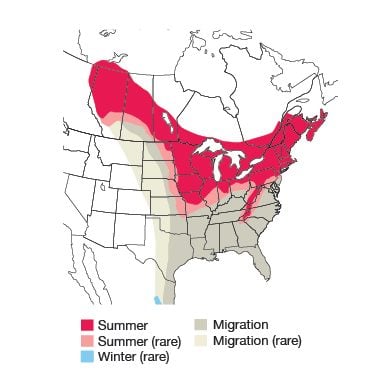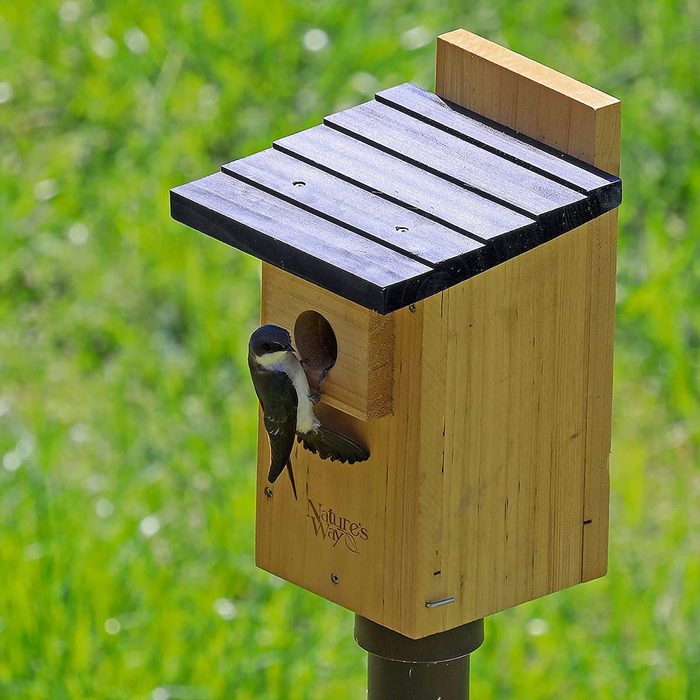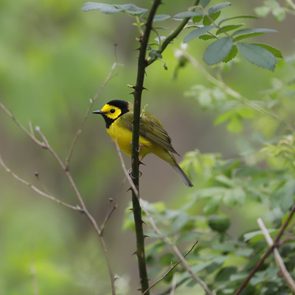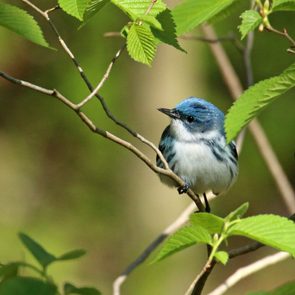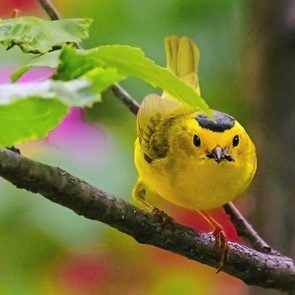
There’s no greater joy for a gardener than a plot full of perfect-looking flowers or vegetables. The problem is that many garden bugs use our flower and vegetable beds as a salad bar. But instead of looking to pesticides for help, you can still have a beautiful garden just by following these simple, natural and cost-effective tips for dealing with garden insect pests.
On This Page
Start with “Clean” Soil
Good soil can actually deter garden insect pests. But it takes time to prepare. Here’s a method that works great:
- First till in organic matter like compost when the growing season begins. This will keep your soil clean by adding natural elements and compounds that help keep pests away.
- After tilling, cover your garden with black plastic or cardboard for 6 months. The heat that builds up underneath it will kill most garden pests and their eggs, weeds, parasites and a host of other harmful microorganisms.
- After removing the plastic, lightly cultivate the soil. Now you’re ready for planting.
Buy Disease and Pest-Resistant Seeds
It’s easier to prevent diseases and pests than it is to get rid of them after they arrive in your garden. When you look at seeds in a catalog, look for letters like V, F, N or T after the name of a seed; they indicate the problems to which the seed is most resistant. V and F stand for verticillium and fusarium, respectively-two diseases that affect tomatoes; N is for nematodes; and T is for tobacco mosaic virus, which causes leaves to wilt and yellow and damages the plant’s roots.
We found mosquito-repelling plants you need in your backyard ASAP.
Selectively and Aggressively Thin Out Plants
This is essential because small, weak seedlings are more likely to become diseased. And they, in turn, may pass the problem on to healthy plants. So be sure to prune away dead shoots and branches that restrict airflow. Plants need good air circulation to breath and stay healthy. Learn how and when to thin vegetable seedlings.
Water Plants in the Early Morning
Why? Well, plants primarily need water to help with photosynthesis, which occurs during the day. Also, if you water later in the day, the leaves will be damp during the cooler nighttime—an ideal condition for promoting fungus and other diseases. When you do water, soak the roots rather than getting the foliage wet. Soaker or drip hoses are a good investment. Follow these tips to conserve water in the garden.
Control Weeds
Weeds compete with your plants for valuable resources such as water, nutrients and light. And they often harbor garden insect pests and parasites, too. Be sure to pull weeds and their roots completely out of the ground.
Grow nasturtium flowers to keep bad bugs away.
Keep Your Garden Clean
Removing faded blooms, fallen leaves and weeds is important because decaying plant matter is a prime breeding ground for fungus, garden bugs and diseases. Carry a small pail or bucket with you every time you enter your garden and use it to collect garden litter.
Here’s how to get rid of powdery mildew.
Use Insect Traps
Yellow “sticky” cards are available at most garden centers. When placed on the ground and in between the shoots or branches of plants, they’ll catch many garden bugs that are traveling through your garden. Contact your local garden center or county extension agent for help in identifying the good garden bugs versus the bad ones.
Find out how to control and get rid of grasshoppers.
Add Beneficial Insects

Insects like ladybugs can be invaluable in the fight against garden insect pests. They eat aphids, mites and the eggs and larvae of many destructive insects. Other beneficial garden bugs include praying mantises, lacewings and parasitic wasps. Most beneficial insects can be purchased from large horticultural supply companies. Your county extension agent can help determine the quantity you’ll need for your garden. One important thing—don’t use any chemicals for 10 days before releasing these insects.
Psst—discover 8 bugs you should never kill in your garden.
Practice Crop Rotation
If you grow the same crop in the same place each year, the specific garden bugs that attack that crop will remain in the area, waiting for the next spring planting. Rotating crops also helps keep vital soil nutrients from being depleted. For instance, plant legumes (which put nitrogen into the soil) where you last planted tomatoes, corn or squash (which deplete nitrogen in the soil).
Pinch Off Dead or Infested Leaves
When you first see signs of diseased leaves, pluck them off. This will stop them from contaminating the entire plant.
Stop the tomato hornworm from damaging your tomatoes.
More Ways to Keep Bugs Out of Your Garden

“We put a bluebird house at the edge of our garden, and the birds manage the bugs for me. The plants lure the bugs, which are an easy meal for the bluebirds,” says Birds & Blooms reader Monica Partington of Raleigh, North Carolina.
“I grow mostly native trees, shrubs and perennials, and now the plants play host to certain insects that attract a variety of birds. It’s a win-win that requires no management from me,” says Birds & Blooms reader Sarah Miller of Avondale Estates, Georgia.
“To control ants, I sprinkle cinnamon along their trails and on their hills,” says Birds & Blooms field editor Jennifer Broadstreet Hess of Marion, Kansas.
“Japanese beetles invade our garden every spring. I put a squirt of lemon Ajax dish soap and a cup of water in a pot, then knock the beetles into the pot,” says Birds & Blooms reader Martha Russell of Carmel, Maine. Discover more tips for managing Japanese beetles.

“I’m a big fan of companion planting. One of my favorite combinations is alternating rows of carrots and onions. Together, they keep carrot flies and onion maggots away,” says Birds & Blooms field editor Sue Gronholz of Beaver Dam, Wisconsin.
“To keep slugs from eating tender young foliage, use horticultural-grade diatomaceous earth sprinkled around plants. Fresh herbs such as lemon balm also keep bad bugs away,” says Birds & Blooms field editor Kathy Eppers of Aledo, Texas.
Next, learn how to keep squash bugs out of your garden.
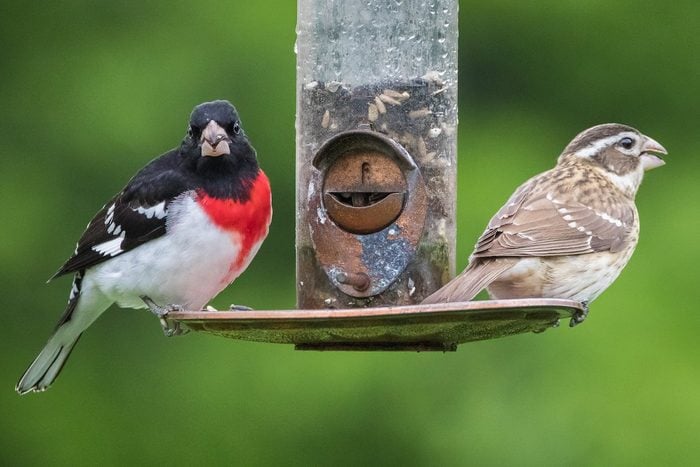
Male Rose-Breasted Grosbeak
To some birders, spotting a rose-breasted grosbeak is a definite sign of spring. Rose-breasted grosbeaks show up east of the Rockies in spring. Males are dressed to the nines in black and white with a red ascot-like marking on their chests. Their bold feathers make them easy to identify. These birds measure about 8 inches long with a 12 1/2 inch wingspan.
Check out 5 types of grosbeaks backyard birders should know.
Female Rose-Breasted Grosbeak
Females sport a more subtle look and are harder to identify because of their drab coloring. They are brown and white with a striped breast and a dark cheek patch. Look for long white stripes above their eyes on a heavily streaked brown body with yellowish underwings. As different as they are, both share one easily recognizable feature: thick conical bills.
Don’t miss these outstanding pictures of rose-breasted grosbeaks.
Nests and Eggs
Pairs build a lightly woven cup shaped nests made of twigs, grasses and leaves. From late spring to summer, the female lays up to five bluish or greenish speckled eggs. Rose-breasted grosbeaks build their nests so loosely that the eggs they lay can occasionally be spotted through the bottom.
A nest is usually located on a tree branch 5 to 20 feet off the ground, but sometimes can be much higher and closer to the forest canopy. “Rose-breasted grosbeak nests are often very high in trees, so they can be hard to spot from the ground,” says Emma Greig, a project leader for the Cornell Lab of Ornithology’s citizen science program Project FeederWatch.
Both males and females spend time incubating the eggs and then quietly sing to each other. Eggs hatch in about 13 days under the watchful eyes of both parents. If a pair raises a second brood, the male may take charge of the first while his mate sits on the new eggs. Males and females share incubation, brooding and feeding duties.
Get to know gorgeous blue grosbeaks.
Juvenile Rose-Breasted Grosbeak

Immature birds are brown and heavily streaked. Young males look like a blend of a female and male with a white eyebrow and a less visible chest patch. Within two weeks, the chicks leave the nest.
Learn how to identify baby orioles and juvenile orioles.
What Does a Rose-Breasted Grosbeak Eat?

Rose-breasted grosbeaks mostly stick to foraging for insects, seeds and fruit in the foliage of trees, but they will come to backyard feeders. Make sure your feeders are full during migration months, when they’ll need the most energy. Draw in these timid, stocky birds by setting up several feeders filled with birdseed or peanuts. Be sure to provide generous perching room. “A great way to attract rose-breasted grosbeaks to your yard is to offer black oil sunflower seeds in a platform, hopper or large tube feeder,” Emma says.
Ensure that the young get a healthy start by offering a habitat filled with native plants that attracts a steady diet of insects. “Even though adult rose-breasted grosbeaks love seeds and berries, their young are fed mostly insects,” says Emma. “This is because the young need the extra protein for their growth.”
I have fed orioles for years but had an awesome surprise the day I took this photo (above). I was thrilled when rose-breasted grosbeaks showed up,” says Pam Garcia.
Did you know: evening grosbeaks and pine grosbeaks are special winter visitors.
Attract Rose-Breasted Grosbeaks With Plants

You’ll have a better chance of attracting these fliers if you plant berry-producing trees and shrubs.
- American elderberry
- Arrowwood viburnum
- Blueberries
- Flowering dogwood
- Mountain ash
- Red mulberry
- Serviceberry
- Virginia creeper
Rose-Breasted Grosbeak Song
Their song is similar to an American robin’s whistle, but faster and more musical. Upon arriving around May from their wintering grounds in Mexico, Central America and northern South America, these songbirds kick off courtship. The males’ melodies are designed to attract mates, claim territory and warn off competitors. Males are known to sing more than 650 times per day. The male’s courtship dance can consist of the head tipped back and tail spread out and held upright while the bird flashes its rose-colored underwings.
Bird songs provided by the Cornell Lab of Ornithology.
Habitat and Range Map

Look for these birds in deciduous and mixed woods, also well-wooded residential areas and parks. They are primarily spotted in the eastern half of the country and are summer residents in northern states. Interestingly, they cross paths and sometimes mate with black-headed grosbeaks in the Great Plains, resulting in hybrid offspring.
Birds & Blooms reader Neil Farrell spotted this bird outside of its normal range and asked our experts about the sighting. “A male rose-breasted grosbeak appeared in my California backyard last May. How’d he get here?”
Kenn and Kimberly Kaufman say, “Rose-breasted grosbeaks are mostly eastern birds, spending the summer in the northeastern U.S. and eastern Canada, and wintering from Mexico south through Central America to northern South America. Their main migration routes are east of the Rocky Mountains. But every year some stray from the normal routes used during spring and fall migrations, and they show up at scattered sites throughout the western states. This seems to happen most often in spring, probably involving birds that go off course as they move north out of Mexico.
Range maps provided by Kaufman Field Guides, the official field guide of Birds & Blooms.
On This Page
Thrush Bird Family Overview

For most backyard birders, thrushes tend to fly under the radar. But you may be more familiar with this varied group than you realize. Although they may not look it, American robins and bluebirds are both part of the thrush bird family.
More than two dozen species of thrushes have been observed in North America. Many of them are rare, strong-flying strays that have wandered far from Europe, Asia or the tropics. But several common types of native thrushes are worth looking for, too.
Six species of thrushes with brown backs and spotted chests live in forests across North America. They sing from the trees but do most of their feeding on the ground, hopping and running in the shadows. What they lack in bright colors, they more than make up for with the beauty of their songs. Most brown thrush species live in the far north or in high mountains during summer.
Wood Thrush

The wood thrush is found all over the eastern states, in forests or in backyards with lots of trees and thickets. It’s the largest species of this thrush group (but still smaller than an American robin) and the one with the boldest black spots on its chest. The foxy reddish brown of its head and upper back is hard to notice when it loiters in deep shade. Wood thrushes sometimes venture to the edges of lawns, making them much easier to spot. Like most of their relatives, wood thrushes migrate to the tropics for the winter.
Hermit Thrush

The only brown thrush bird you’re likely to see in the cold months is the hermit thrush. Some stay through the winter all across the southern states, from California to the Carolinas, and a few as far north as the Great Lakes.
This thrush also migrates later in fall and earlier in spring than its relatives. Spot its reddish brown tail, contrasting with a dull brown back. When the hermit thrush pauses in the open, it may raise and lower its tail while flicking its wings out to the side in a nervous-appearing motion.
Discover more small brown birds you might see.
Townsend’s Solitaire

When you walk through open juniper woods in the West in winter, listen for a small bell ringing in the distance. This is the call note of Townsend’s solitaire, a slim gray thrush with a bold white eye-ring.
Solitaires are usually seen alone, as their name suggests, perching bolt upright in the open. They fly out to catch insects in midair or flutter down to pick them from foliage. In cold weather, they eat mostly berries. For the summer, most solitaires move to the higher mountains. They build their nests on the ground, well hidden under logs or in protected spots among rocks.
Varied Thrush

At first glance, it’s easy to mistake this thrush for a robin. A chunky, shorter-tailed bird, it’s more shy than its robin cousin. This bird hides in dense forest cover, where it can be hard to see, but it’s worth the effort to get a good look. The varied thrush has a striking pattern, with an orange eyebrow, complicated orange wing stripes and a dark band across the chest. Varied thrushes are most common in the Pacific Northwest.
In summer, they live in cool evergreen forests from southern Alaska to Idaho and northwestern California. Males perch in treetops to sing a long breathy note that sounds as if they’re whistling and humming at the same time.
For winter, most varied thrushes move south in the Pacific Coast states, though a few go off-course and fly to the east. Wandering varied thrushes have been seen in almost every eastern state and all along the Atlantic Coast, from southern Canada to Florida.
Such a surprising visitor could show up anywhere. Make sure you take a second look at every robin that visits your backyard. It just might be a varied thrush!
Swainson’s Thrush

To identify a Swainson’s thrush, look for a compact shape, brown back, spotted chest, and fairly long pale legs. Look closer to spot a distinctive face pattern and bold buffy eye ring, almost as though the bird is wearing a pair of spectacles.
Swainson’s thrushes are found all across Canada and Alaska in summer, in addition to parts of the northern and western states. They spend the winter in Central and South America, as well as southern Mexico.
Do robin sightings have meaning?
Thrush Bird Songs

Accomplished singers, thrushes deliver some of the most beautiful bird songs in North America.
- Wood Thrush: a rich, deep fluting whistle (ee-oh-lay).
- Hermit Thrush: one long, clear note and then a short, quick warbling phrase.
- Swainson’s Thrush: a short, low note followed by whistled phrases; at the end a higher note.
- Veery: breezy whistles that spiral down (veeyurr, veeyurr, veeyurr).
- Gray-cheeked thrush: whistled phrases with a nasal tone (veeyer, vidi veer, de veer).
- Bicknell’s Thrush: like the gray-cheeked thrush but thinner; ends on a higher note.
Next, learn more about thrasher birds.

Being a bird landlord and managing a nest box is an exciting way to help your feathered neighbors, but it comes with great responsibility. According to Dan Sparks, who has been involved with Indiana’s Brown County Bluebird Club for nearly 30 years, it is important that birdhouses provide good ventilation without compromising protection from the elements. How to care for it is another essential. “The box should easily open from the side, front or top for cleaning and monitoring,” Dan says.
To boost your chance of attracting nesting birds, follow these basic birdhouse guidelines. You can actually attract different species to unique nesting boxes based on the size of the entrance hole, the location, and more.
Here are more things to consider.
Say No to Fancy Birdhouses

Fancy or extra-elaborate birdhouses are nice to look at, but they are often not functional. When these pretty abodes are made of metal, the temperatures may get unsafe inside the box. Painting wooden boxes with nontoxic paint on the exterior months in advance can allow any fumes to dissipate, and some nest box monitors choose light colors of paint to help keep internal temperatures down. But the Cornell Lab of Ornithology’s NestWatch website recommends erring on the side of caution and sticking to untreated and unpainted wooden boxes.
However, if you want to display a more decorative birdhouse that isn’t going to be functional, simply cover the hole with a wooden block or a copper or plexiglass plate. Blocking access to such birdhouses before placing them outside will keep birds safe while also bringing a bit of whimsy to your space.
When do bluebirds nest and lay eggs?
Offer a Good Roof and Air Conditioning

Birdhouses with sloped overhanging roofs are preferable to help prevent rain from getting inside, according to Dan. Channels or grooves cut under the edges of the roof are added features that function as mini rain gutters. Drainage holes and recessed floors prevent dampness from accumulating on the bottom of the box. Ventilation holes should be near the top of the box to allow hot air to escape.
Follow these proven tips to attract nesting birds.
Location, Location, Location

Put out birdhouses early in the season—by February in the South and mid-March in the North. Bluebirds and swallows prefer mounted boxes in open areas. Wrens and chickadees are comfortable with hanging houses closer to cover or in the woods. It’s tempting to put nest boxes near feeders to create a bed-and-breakfast of sorts, but it’s best to keep them separate. The bustle of activity around feeding stations isn’t conducive for raising babies—and it might attract predators. Most species like to nest in isolation, but a few birds, including purple martins, are communal nesters and require special boxes with multiple chambers.
Find out how long baby birds stay in the nest and more nest facts.
Evict Squatters

In North America, nonnative European starlings and house sparrows are unwelcome squatters. Smaller entrance holes keep starlings out in most cases, but both species can be problematic in boxes with larger entrance holes and in communal houses like those for purple martins. Dan suggests removing house sparrow nests, although he notes that it can take multiple attempts because house sparrows are persistent. NestWatch and the North American Bluebird Society websites both note that humanely euthanizing house sparrows and European starlings is another management method, since these two species, including their nests, are not protected under the Migratory Bird Treaty Act.
Welcome nesting wrens to a wren birdhouse.
Keep Out Unwanted Guests
Although nest predation is a natural process, you should attempt to minimize it in your nest boxes. Snakes, raccoons, squirrels and chipmunks are just a few of the potential predators to deter. Baffles are effective at preventing critters from having access to a nest box. Hole extenders or predator guards can be attached to boxes to make it more difficult for predators to reach into a nest box and grab the eggs or nestlings. Perches aren’t necessary for cavity nesters, so they should be removed from boxes. This helps minimize access for unwanted house guests too.
Learn how to make DIY nesting shelves for birds.
Monitor Regularly

It’s important to keep track of nesting progress. “Remove any attempts of wasps to build a nest, and check for ants and blowflies,” Dan says. Monitoring is also helpful to “make sure eggs are in the nest cup and are being rotated,” he says. According to NestWatch, nest boxes should be monitored at least weekly, but not more than every three to four days, which is the right balance between overly disturbing the nest and neglecting it. And it’s best to approach a nest after the female has left the box on her own.
Will hummingbirds use a birdhouse?
Clean Birdhouses Often
Having a nest box that opens easily is essential. Dan says that “it is best to remove the nest at the completion of each nesting attempt.” Depending on the species, birds raise up to three broods per nesting season, so cleaning a nest box between nesting attempts is important “for sanitary reasons and to make it farther for a predator to reach to grasp an egg or nestling,” Dan says. Cleaning out the boxes helps freshen them for the next nest and protects future nestlings from diseases and parasites too.
Tree Swallow Dimensions
- 5″ x 5″ x 8″ h.
- Hole 1 ³/₈” centered 6″ above floor
- Placement 5 to 8′ high in the open; 50-100% sun
House Wren Dimensions
- 4″ x 4″ x 8″ h. or 4″ x 6″ base
- Hole 1″ centered 6″ above floor
- Placement 5 to 10′ high on a post or hung in tree
Pygmy Nuthatch Dimensions
- 5¹/₂” x 5¹/₂” x 8″ h.
- Hole 1″ centered 7″ above floor
- Placement 3 to 25′ high in open areas of pine forests
American Kestrel Dimensions
- 10″ x 10″ x 24″ h.
- Hole 4″x 3″ elliptical 20″ above floor
- Placement 12-40′ high on a post or tree trunk
Birdhouses That Birds Will Actually Use
Decorative birdhouses are fun, but not always practical for birds. These unique, species-specific options provide safe nesting spots for your feathered friends.
Bluebird House
Bluebirds have very specific nesting requirements, so you want to make sure to mount this box on a pole and place it in an open area. This birdhouse is recommended by the North American Bluebird Society. You may also welcome a family of tree swallows!
Learn how to attract bluebirds.
Rustic Wren Birdhouses
Wrens will adore this little birdhouse that looks like a country barn. The tiny 1 1/8 inch hole is just big enough for the birds, but small enough to keep out predators. Plus, there’s no perch, which helps deter sparrows. Open up the bottom panel for easy cleaning.
You need to see these super cute pictures of baby birds.
Purple Martin Gourds
If you want to attract purple martins, then try hanging up these white plastic gourds. Choose from a pack of 4, 6 or 8; each has a drainage hole. Starling guards and mounting hardware is included.
Want to DIY? Learn how to make your own a purple martin gourd house.
What Birds Eat Grape Jelly?
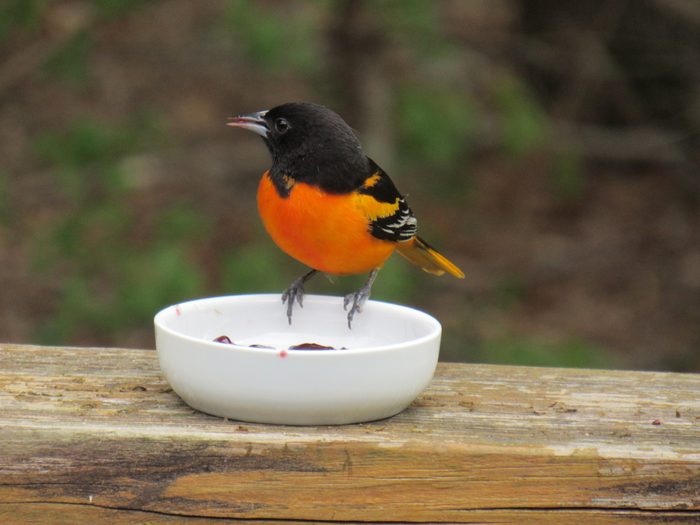
Grape jelly is a magic lure for some birds. Fruit-eating birds like orioles, catbirds and tanagers can’t get enough of the stuff, especially in early spring, when their usual sweet treats are hard to come by. And as migrating birds make their long journeys north, they’re especially inclined to stop by backyards that feature energizing jelly on the menu.
Orioles aren’t too picky when it comes to jelly, but Bullock’s orioles and Baltimore orioles in particular love the grape flavor, because it tastes similar to the dark, ripe fruits they normally eat, grapes included.

Watch your feeder long enough and you might also see other birds eat grape jelly, like robins and gray catbirds, which are attracted to yards that offer both jelly and a water source. Additional birds that visit these sweet feeders, especially during their migration, include summer and scarlet tanagers, northern mockingbirds and rose-breasted grosbeaks. Woodpeckers and house finches might also stop by.
Learn how to attract orioles to your backyard.
Grape Jelly Bird Feeding Tips

“What are some general guidelines for feeding grape jelly to birds?” asks Nancy Jenks of Galesville, Wisconsin.
Birding experts Kenn and Kimberly Kaufman say, “Grape jelly is not harmful in small amounts, but jelly doesn’t provide all the nutrients birds need. Think of it as a snack or dessert, not a main course, and use limited amounts at a time.”
Find out what other foods orioles eat.
“It’s OK to provide a little more during peak spring migration for orioles (April in the South and early May in the North), but after the local breeding season starts, a quarter of a cup per day is a good rule. Smaller amounts are also less likely to spoil in hot weather or to get sticky residue on the birds’ feathers,” the Kaufmans explain.
Learn how to identify orchard orioles.
Jelly Feeders for Orioles

The best way to set out jelly is in a tray or dish about 1 inch deep and 3 to 4 inches wide. Wild bird feed supply stores offer different types of jelly feeders. One popular style of oriole feeder features a small glass dish. You can also hang a jelly feeder on a bird feeder pole for extra protection. Just make sure you keep it away from marauding squirrels and in a place where you can easily clean and refill it.
Although there’s no way to stop bees from taking advantage of jelly served from open-style feeders, oriole feeders with bee guards are also available. They have a design similar to a hummingbird feeder. You can fill them with sugar water or try this oriole nectar recipe.
You should purchase jelly that doesn’t have artificial sweeteners, colors and flavors. Check the jelly daily to watch for mold. Always clean the feeder out and add fresh stuff if the jelly starts looking dubious.
Never add these foods to your hummingbird mixture.

Get your jelly feeder up in April, when migration is in full swing. It may take some time for orioles to find your jelly feeders. Birds need to feed their young protein-rich foods, like insects, but once the offspring have fledged, their parents often bring them to jelly feeders. Here’s how to identify baby orioles and juvenile orioles.
The feeder will probably see less and less action as summer continues, but things should pick up again during fall migration.
Next, we asked the experts if birds can eat peanut butter.

Backyard warbler sightings can be pretty rare, since most of these birds don’t frequent feeders. From time to time, though, yellow-rumped warblers will drop by for a snack. Learn how to identify and attract these birds.
What Foods Do Yellow-Rumped Warblers Eat?

Like many other warblers, yellowrumps gorge themselves on insects throughout the warmer months. But they switch to berries in fall and winter, especially bayberry and wax myrtle fruit.
“It’s actually difficult for animals to digest wax, but the yellow-rumped warbler can,” says Kevin J. McGowan of the Cornell Lab of Ornithology’s Bird Academy. “Wax myrtle and bayberry are abundant along the East Coast, and because this warbler can eat their berries, it can winter all the way north to Nova Scotia.”
In fact, Kevin theorizes that this is why yellow-rumps are one of the few warblers to visit backyard buffets. “They use feeders more when the local crop of wax myrtle or bayberry fruits get low,” he says. “They especially like suet and peanut butter.”

Entice adaptable yellow-rumped warblers with this natural red cedar bird feeder house.
Learn more about what foods warblers eat.
What Does a Yellow-Rumped Warbler Look Like?

As their affectionate “butterbutts” nickname and their common name both imply, these birds boast a bright yellow patch on the lower back, just above the tail. During spring and summer breeding, both sexes are gray and black with small patches of yellow at the sides of the chest and on the center of the crown. Winter lightens the grays into browns, but the yellow rump remains a constant throughout the seasons.
The Myrtle subspecies, with its white throat and eyebrow stripe, is more common in the East. Out west, the Audubon’s has a yellow throat and no eyebrow stripe.
At the Lagerman Agricultural Preserve in Longmont, Colorado, I got this shot of a male yellow-rumped warbler of the Audubon’s subspecies (above),” says Carl Muehlemeyer of Broomfield, Colorado.
Learn what a yellow warbler looks like.
Nests and Eggs

When spring arrives, yellowrumps head farther north to pair up and breed. Out west, they also work their way higher up into the mountains, looking for the coniferous forests they love. The white-throated myrtle nests from New England to Alaska, and the yellow-throated Audubon’s nests throughout the forests and mountains of the West.
Females build nests in a variety of trees, where each bird can lay up to six speckled eggs. She does most of the incubation herself, but her mate helps feed the hatchlings until they fledge, which takes about two weeks. A pair may raise two broods a year.
Attract a prothonotary warbler with a birdhouse.
Migration
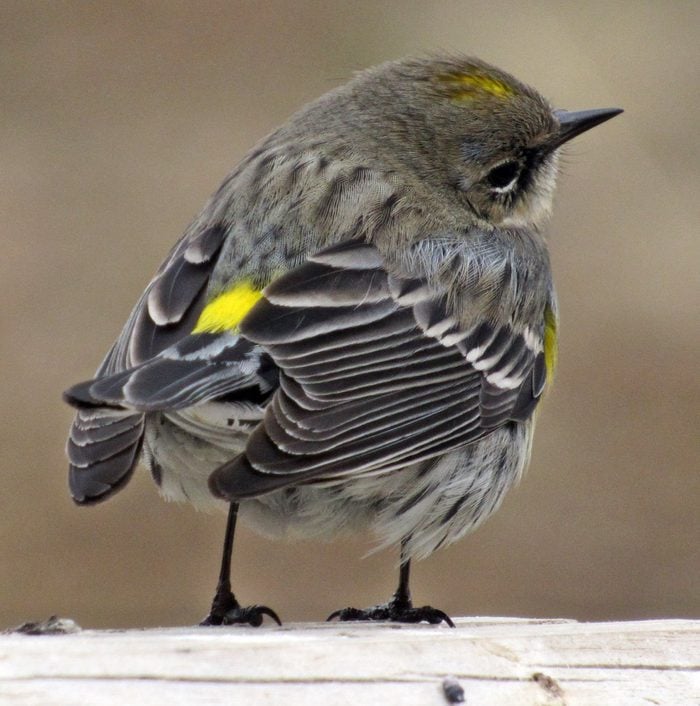
To draw butterbutts in during spring migration, offer peanut butter, berry-filled suet or raisins, along with refreshing water features for them to enjoy. “Yellow-rumped warblers are the last warblers in fall to migrate through,” Kevin says. This also makes them one of the last to arrive in their wintering grounds throughout the southern U.S. and down through Central America. By late winter, when some berry crops are low, expect to see yellowrumps on feeders more often.
This warbler winters widely across the United States and can thrive in cold weather without migrating to the tropics.
Don’t miss these breathtaking Blackburnian warbler photos.
Range

North America boasts more than 50 species of warblers; this one is probably the most abundant. Their population may be as high as 150 million. There are four forms, all with distinct appearances. Look for myrtles in the East and far North and Audubon’s in the West. The other two forms live in Mexico and Guatemala.
Learn how to identify a palm warbler.
Call

If you’re near a bayberry or other myrtle shrub, listen for the yellow-rumped warbler call—a signature sharp chip.
Primrose Flowers Have Played a Part in Pop Culture

These bright delights have cemented a place in literature and popular culture; Shakespeare included the primrose flower as a symbol in many of his plays. More recently, in Suzanne Collins’ 2008 young adult novel The Hunger Games, main character Katniss’ sister is named after the evening primrose.
Want more nature trivia? Check out these fun facts about birds in pop culture.
Multiple Types of Primrose Flowers

There are two types of unrelated flowers that are called primroses. One simply goes by the name primrose (Primula spp.) and the other is called evening primrose (Oenothera spp.).
Did you know that primroses are one of the birth flowers for February?
Primrose Flowers Come in Many Colors

More than 400 species of primroses exist, appearing in many colors including red, pink, purple and gold. They’re a hardy flower, thriving in mountain ranges, marshes and other varied habitats.
Backyard Tip: Evening primrose reseeds and may spread aggressively in your garden. Consult your local extension agent before planting if you have concerns about it becoming invasive in your area.
Psst—planting a moon garden improves your chances of spotting a sphinx moth.
Does a Primrose Have Meaning?

Primrose means “first rose,” and it’s certainly accurate. Primroses are one of the first flowers to appear in many different environments, blooming in Zones 3 to 8 in early spring. If you’re looking for more early blooming spring flowers, check out our list.
English primrose plants are considered some of the best old-fashioned flowers to grow.
Primroses Have a Long Medicinal History
While Europeans grew evening primroses in the 17th century, the plant’s history starts long before then. Native Americans used the plant to heal wounds, serve as a sedative and even treat hemorrhoids.
Discover 20 mental and physical health benefits of gardening.
Primrose Flower Care
Primroses provide blooms for up to 10 weeks if deadheaded. They do well in cool temps with a fair amount of moisture. Place in a spot with afternoon shade to keep them looking their best.
Next, learn how to grow Lenten rose plants.
Climbing Rose Not Blooming
“Last year I planted a new hybrid tea climber. It grew vigorously but produced not one sign of a bud or flower. Can you tell me how it’s possible to have a healthy climber without blooms?” asks Beulah Maurer of Greenville, Ohio.
Horticultural expert Melinda Myers: Like many hybrid tea and floribunda roses, hybrid tea climbers are grafted onto a hardy rootstock. If the graft union dies, the rootstock will take over and produce lush, often thornier growth with different flowers, or none at all. If this is not the problem, evaluate your pruning practices.
Most climbers bloom on old wood, so pruning needs to be limited and timed appropriately. Older or winter-killed stems should be removed in late winter or early spring, before growth begins. Do additional light pruning after the first flush of flowers fades.
How to grow roses: what you need to know.
Rose Bush Without Flowers
“Last spring my rose bushes were covered in sprouting leaves that didn’t produce flowers. Is it too late to prune when roses are not blooming?” asks Denise Martin of Justice, Illinois.
Melinda: Repeat-blooming roses are best pruned after the worst of winter weather has passed and before growth begins. Roses that only bloom once a year are typically pruned after the flowers fade. At this point, you may want to wait until the leaves are fully expanded to reduce the risk of damaging the canes during the pruning process.
Last year’s lack of blooming on your roses may indicate a problem unrelated to pruning, though. Many roses are grafted by placing a bud from the desirable rose onto a set of hardy roots. If this graft union (where the bud connects to the roots) fails from winter cold or another cause, the roots take over producing all the new growth.
The stems that sprout from the roots are often stouter and have more thorns. They may be covered with just leaves, or they may produce flowers that are different than those of the original plant.
Learn how to prepare and prune roses for winter.
Roses That Change Color

“I salvaged the roots of a pink rambling rosebush that had been mowed down and neglected. I gave it lots of TLC for three years before planting it in the ground. Finally, three years later, it came back to life, flourished and the rose is now blooming red. Why is that?” asks Mary Wallace of Kell, Illinois.
Melinda: It sounds as if the graft died or was mowed off and the hardy rootstock took over. The desirable bud of hybrid tea and grandiflora roses were—and many still are—grafted onto a hardier rootstock. If cold weather, mowing or animals damage the graft, the desirable top of the plant dies and the rootstock takes over. I’m afraid your pink rose is gone. You can embrace the red rose or replace this plant with one you prefer.
Psst—roses love garlic: find out why.
“The yellow rosebush in my garden is producing velvety red flowers. How did this happen?” asks Carol Grajzar of Silver Creek, Georgia.
Melinda: Roses are often grafted onto the roots of a different variety to speed development and increase hardiness. If the graft dies, the desirable rose disappears and the hardier rootstock takes over producing its own flowers.
Backyard tip: If a rose graft dies, leaf color and shape or even flower color may change.
Learn how to treat black spot and rose rosette disease.
Easter Cactus Care

While some other types of cacti might bloom around Easter, they’re not technically an Easter cactus. That title goes to a different plant: Rhipsalidopsis gaertneri. With the common name “Easter cactus” or “spring cactus,” it thrives in cooler spring temperatures.
Easter cactus bears long-petaled pink, red, orange, white or purple flowers that open at sunrise and close in the evening. It likes bright, indirect light to grow its best, but won’t tolerate full sun. This drought-tolerant plant also requires loose soil so that its roots have access to air. Generally, this succulent doesn’t require much tending. Water it only when the soil is dry; water more often in the spring and summer than in fall and winter.
Interested in growing a succulent, but not sure how to start? Check out our guide to growing succulents—indoors and out.

Things get a little more granular, though, when it comes to getting your Easter cactus to produce those gorgeous flowers. In order to bloom between the months of March and May, it needs to be kept at about 50 degrees Fahrenheit at night.
As a fun fact, Easter cactus shares similarities with two other well-known holiday plants: Thanksgiving cactus and Christmas cactus. While they’re not in the same family, they all do best in cooler weather—notice they’re associated with winter or spring holidays—and sport angular, vibrant blooms.
Psst—check out pretty Easter flower arrangements we’re ordering this spring.
Rose Pincushion Cactus Care

Birds & Blooms reader Elizabeth Ann Mingus shared this photo (above) of another cacti that blooms around Easter and asked for help to identify it.
Horticultural expert Melinda Myers says, “This prickly beauty is a rose pincushion cactus that goes by the botanical name Mammillaria zeilmanniana. It is a prolific bloomer, as you’ve discovered, with pink to red or—occasionally—white flowers topping the plant. Like all cacti, it prefers full sun and well-draining soil. This particular cactus is only hardy in Zone 10 and milder climates. It can be overwintered indoors in colder regions or grown as a houseplant year-round.”
Next, check out cute cactus gifts for cactus lovers.
